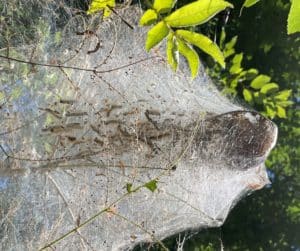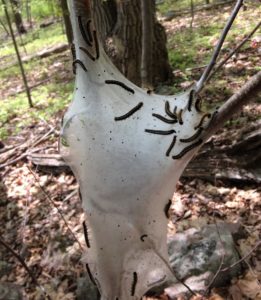Hello fellow readers, Have you noticed what looks like cotton candy decorating trees? I thought they were Eastern tent caterpillars, also called tent worms, we see in spring. But it turns out the white webs, often two feet wide, are fall webworms –tent worms’ close cousins.

Fall Webworm nests decorating trees.
Comparing the close Cousins: Fall Webworms vs. Tent Caterpillars:
Both feed on shade, fruit, and woodland trees. But the fall webworms (Hyphantria cunea) pitch their tents in the late summer or early fall around branches and feed on them while “camping.” And so, they are filled with fecal droppings and food remnants.
In comparison, the Eastern tent caterpillars make their tents in the spring in a fork of branches and then leave their campsites to eat leaves of nearby trees, returning in the evening or during rainy weather to hunker down. So their abodes are “tidier.”
Think of them as diehard campers with a nifty lifecycle

Fall Webworm abodes aren’t as “tidy” as Tent Caterpillars.
The Penn State Extension Office writes tent caterpillars have been around since 1646, with outbreaks every eight to ten years. Their favorite feasts are cherry, crabapple, and apple trees. Like their close cousin, their feasts rarely kill a tree though folks blamed the poor little fellas for being a significant defoliating pest until the gypsy moth outbreak of 1970.
Fall webworms commonly make crabapple, walnut, birch, and cherry their meal of choice, though they feed on 90 species of deciduous trees.
Grown-up fall webworms are hairy, about an inch and a half long, bluish-black or yellowish with dark spots and stripes. The adult moths are almost purely white; some have black speckles.
Eastern tent caterpillars (Malacosoma americanum) are not very hairy. They’re white and black with blue markings, about two inches long, with a distinctive white stripe in the middle of their backs. They are the larvae of a moth known as lappet or snout moths that are reddish-brown with whitish stripes.
Safe ways to remedy Fall Webworms or Tent Caterpillars if need be

Eastern Tent caterpillars feed outside of their nests.
Tent caterpillars can be toxic to horses, mules, and donkeys; I’ve not heard the same about fall webworms. While they can significantly defoliate, they usually won’t kill trees. If need be, you can destroy the nests by dropping them into soapy water. Or use a safe for the environment contact insecticide.
Bacillus thuringiensis (Bt) is the most effective and is a naturally occurring bacterium common in soils. It’s a selective insecticide killing caterpillars while safe for other wildlife. Apply the spray directly to foliage and tent nests. It produces proteins that react with the cells of the gut lining of susceptible insects. These Bt proteins impact the digestive system causing the insect to stop feeding within hours. They then die from starvation, which can take several days—not very kind. Maybe best to let nature take its course.
Think of them as diehard campers with a nifty lifecycle instead of a threat. Besides, the native insects are a food source for our beautiful birds, adorable toads, and beneficial insects. It’s true, though; they can be rather icky when they fall on your plate at a barbeque.
Garden Dilemmas? AskMaryStone@gmail.com or your favorite Podcast App.
There’s more to the story in Episode 71 – including a hilarious intervention of brother Rick’s rose dilemma:
Link to for more about Diehard Campers-Tent Caterpillars
More information about Bacillus thuringiensis (Bt)


